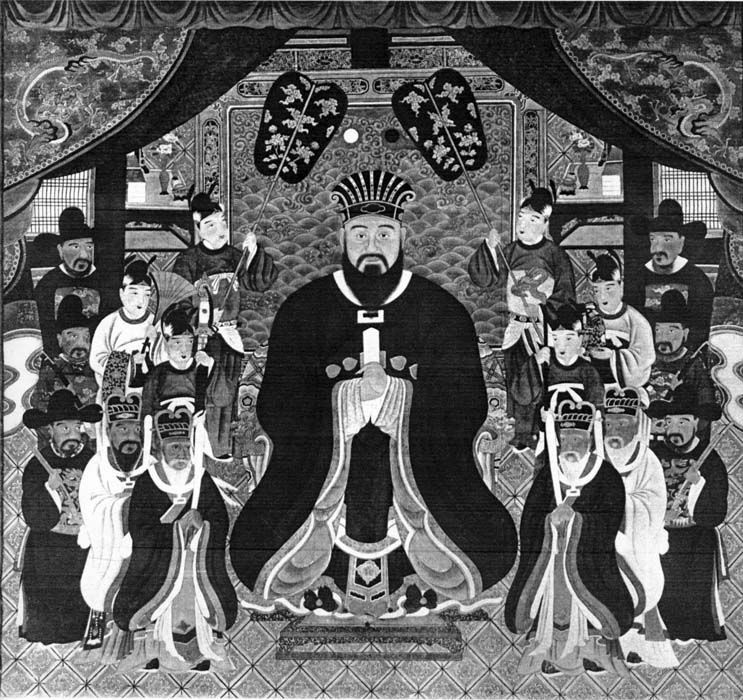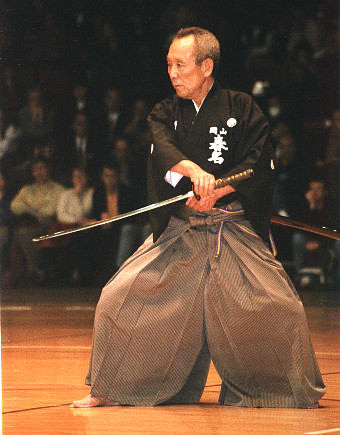|
Kata
''Kata'' is a Japanese word ( 型 or 形) meaning "form". It refers to a detailed choreographed pattern of martial arts movements. It can also be reviewed within groups and in unison when training. It is practiced in Japanese martial arts as a way to memorize and perfect the movements being executed. Korean martial arts with Japanese influence ( hapkido, Tang Soo Do) use the derived term '' hyeong'' (hanja: 形) and also the term ''pumsae'' (hanja: 品勢 hangeul: 품새). Kata are also used in many traditional Japanese arts such as theatre forms like kabuki and schools of tea ceremony ('' chadō''), but are most commonly known in the martial arts. Kata are used by most Japanese and Okinawan martial arts, such as iaido, judo, kendo, kenpo, and karate. Background Kata originally were teaching and training methods by which successful combat techniques were preserved and passed on. Practicing kata allowed a company of persons to engage in a struggle using a syste ... [...More Info...] [...Related Items...] OR: [Wikipedia] [Google] [Baidu] |
Katana
A is a Japanese sword characterized by a curved, single-edged blade with a circular or squared guard and long grip to accommodate two hands. Developed later than the ''tachi'', it was used by samurai in feudal Japan and worn with the edge facing upward. Since the Muromachi period, many old ''tachi'' were cut from the root and shortened, and the blade at the root was crushed and converted into a ''katana''. The specific term for ''katana'' in Japan is and the term ''katana'' (刀) often refers to single-edged swords from around the world. Etymology and loanwords The word ''katana'' first appears in Japanese in the ''Nihon Shoki'' of 720. The term is a compound of ''kata'' ("one side, one-sided") + ''na'' ("blade"),1995, (''w:Daijisen, Daijisen'') (in Japanese), w:Tōkyō, Tōkyō: w:Shogakukan, Shogakukan, , entry available onlinhere/span> in contrast to the double-sided ''Tsurugi (sword), tsurugi''. The ''katana'' belongs to the ''nihontō'' family of swords, and is ... [...More Info...] [...Related Items...] OR: [Wikipedia] [Google] [Baidu] |
Judo
is an unarmed gendai budō, modern Japanese martial art, combat sport, Olympic sport (since 1964), and the most prominent form of jacket wrestling competed internationally.『日本大百科全書』電子版【柔道】(CD-ROM version of Encyclopedia Nipponica, "Judo"). Judo was created in 1882 by Kanō Jigorō () as an eclectic martial art, distinguishing itself from its predecessors (primarily Tenjin Shin'yō-ryū, Tenjin Shinyo-ryu jujutsu and Kitō-ryū jujutsu) due to an emphasis on "randori" (, lit. 'free sparring') instead of alongside its removal of striking and weapon training elements. Judo rose to prominence for its dominance over Kodokan–Totsuka rivalry, established jujutsu schools in tournaments hosted by the Tokyo Metropolitan Police Department (警視庁武術大会, ''Keishicho Bujutsu Taikai''), resulting in its adoption as the department's primary martial art. A judo practitioner is called a , and the judo uniform is called . The objective of competitive ju ... [...More Info...] [...Related Items...] OR: [Wikipedia] [Google] [Baidu] |
Judo Kata
is an unarmed modern Japanese martial art, combat sport, Olympic sport (since 1964), and the most prominent form of jacket wrestling competed internationally.『日本大百科全書』電子版【柔道】(CD-ROM version of Encyclopedia Nipponica, "Judo"). Judo was created in 1882 by Kanō Jigorō () as an eclectic martial art, distinguishing itself from its predecessors (primarily Tenjin Shinyo-ryu jujutsu and Kitō-ryū jujutsu) due to an emphasis on "randori" (, lit. 'free sparring') instead of alongside its removal of striking and weapon training elements. Judo rose to prominence for its dominance over established jujutsu schools in tournaments hosted by the Tokyo Metropolitan Police Department (警視庁武術大会, ''Keishicho Bujutsu Taikai''), resulting in its adoption as the department's primary martial art. A judo practitioner is called a , and the judo uniform is called . The objective of competitive judo is to throw an opponent, immobilize them with a pin, ... [...More Info...] [...Related Items...] OR: [Wikipedia] [Google] [Baidu] |
Kendo
is a modern Japanese martial art, descended from kenjutsu (one of the old Japanese martial arts, swordsmanship), that uses bamboo swords ( shinai) as well as protective armor ( bōgu). It began as samurai warriors' customary swordsmanship exercises, and today, it is widely practiced within Japan and has spread to many other nations across the world. History Swordsmen in Japan established schools of ''kenjutsu'' (the ancestor of kendo). These continued for centuries and form the basis of kendo practice today.. Formal kendo exercises known as ''kata'' were developed several centuries ago as ''kenjutsu'' practice for warriors. They are still studied today, in a modified form. The introduction of bamboo practice swords and armor to sword training is attributed to during the Shotoku Era (1711–1715). Naganuma developed the use of this armor and established a training method using bamboo swords. , third son of Naganuma and the eighth headmaster of the Kashima Shinden Jik ... [...More Info...] [...Related Items...] OR: [Wikipedia] [Google] [Baidu] |
Karate Kata
Kata (, or more traditionally, 型; lit. "form") is a Japanese word describing detailed patterns of movements practiced either solo or in pairs. Karate kata are executed as a specified series of a variety of moves, with stepping and turning, while attempting to maintain perfect form. The kata is not intended as a literal depiction of a mock fight, but as a display of transition and flow from one posture and movement to another, teaching the student proper form and position, and encouraging them to visualise different scenarios for the use of each motion and technique. Karateka "read" a kata in order to explain the imagined events, a practice known as '' bunkai''. There are various kata, each with many minor variations. Origins Kata originated from the practice of paired attack and defense drills by ancient Chinese martial artists, these were known as the "five form fists" or "five patterns" after the fighting methods of five different animals. These were brought to Okinawa and w ... [...More Info...] [...Related Items...] OR: [Wikipedia] [Google] [Baidu] |
Nage-no-kata
is one of the two of Kodokan Judo Institute, Kodokan Judo. It is intended as an illustration of the various concepts of that exist in judo, and is used both as a training method and as a demonstration of understanding. History The ''nage-no-kata'' was developed by Jigoro Kano as a method of illustrating principles of throwing to allow students to more effectively apply them in randori. Initially the kata consisted of ten techniques. These were subsequently appended with the addition of a further five throws, including ''kata guruma'' and ''uki otoshi''. Description The kata is composed of 3 techniques each from the five classifications of throw (grappling), throw in judo: * * * * * Each of these 15 techniques is performed twice in the specified order, both right and left handed. The kata is generally performed in a strictly formalised manner with clearly defined . and approach the mat from opposite sides, with Tori on the left hand of the and Uke on the right (''i.e. ... [...More Info...] [...Related Items...] OR: [Wikipedia] [Google] [Baidu] |
Bunkai
, literally meaning "analysis" or "disassembly", "is a term used in Japanese martial arts referring to process of analysing kata and extracting fighting techniques from the movements of a 'form' (''kata''). The extracted fighting techniques are called ''Oyo''." Process Bunkai is usually performed with a partner or a group of partners which execute predefined attacks, and the student performing the ''kata'' responds with defenses, counterattacks, or other actions, based on a part of the ''kata''. This allows the student in the middle to understand what the movements in ''kata'' are meant to accomplish. It also illustrates how to improve the technique by adjusting distances (Maai), timing, rhythm (Ritsudo) and fluidity (Nagare) in combat properly, in order to adapt and adjust any technique depending on the size of an opponent. Some ''kata'' have another layer of application that is taught using an ''Oyo Bunkai'', an "application of the kata in ways other than the standard bunkai." ... [...More Info...] [...Related Items...] OR: [Wikipedia] [Google] [Baidu] |
Karate
(; ; Okinawan language, Okinawan pronunciation: ), also , is a martial arts, martial art developed in the Ryukyu Kingdom. It developed from the Okinawan martial arts, indigenous Ryukyuan martial arts (called , "hand"; ''tī'' in Okinawan) under the influence of Chinese martial arts. While modern karate is primarily a striking art that uses punches and kicks, traditional karate training also employs Throw (grappling), throwing and joint locking techniques. A karate practitioner is called a . Beginning in the 1300s, early Chinese martial arts, Chinese martial artists brought their techniques to Okinawa. Despite the Ryukyu Kingdom being turned into a puppet state by Japanese samurai in 1609, after the Invasion of Ryukyu, its cultural ties to China remained strong. Since Ryukyuans were banned from carrying swords under samurai rule, groups of young aristocrats created unarmed combat methods as a form of resistance, combining Chinese and local styles of martial arts. Training emph ... [...More Info...] [...Related Items...] OR: [Wikipedia] [Google] [Baidu] |
Hyeong
The Korean terms hyeong, pumse, poomsae and teul (meaning "form" or "pattern") are all used to refer to martial arts forms that are typically used in Korean martial arts such as Taekwondo and Tang Soo Do. * Hyeong (형) is often romanized as ''hyung''. This term is used primarily in earlier styles of taekwondo, often referred to as ''traditional taekwondo''. * Pumse (품세) is often romanized as ''poomsae'' or ''poomse''. This term is used primarily in Kukkiwon/ WTF-style taekwondo. * Teul (틀) is often romanized as ''tul''. This term is used primarily in ITF-style taekwondo. A hyeong is a systematic, prearranged sequence of martial techniques that is performed either with or without the use of a weapon. In traditional dojangs (training halls), hyeong are used primarily as a form of interval training that is useful in developing mushin, proper kinetics and mental and physical fortitude. Hyeong may resemble combat, but are artistically non-combative and woven together so as ... [...More Info...] [...Related Items...] OR: [Wikipedia] [Google] [Baidu] |
Iaido2
, abbreviated , is a Japanese martial art that emphasizes being aware and capable of quickly drawing the sword and responding to sudden attacks.Christensen, Karen and Allen Guttmann et.al (2001) ''International Encyclopedia of Women and Sports: H-R''. Macmillan Reference USA, Page 553. Iaido consists of four main components: the smooth, controlled movements of drawing the sword from its scabbard (or saya), striking or cutting an opponent, shaking blood from the blade, and replacing the sword in the scabbard.John Nauright, Charles Parrish, edited (2012) ''Sports Around the World: History, Culture, and Practice''. ABC-CLIO. Page 226. While beginning practitioners of iaido may start learning with a wooden sword (bokutō 木刀) depending on the teaching style of a particular instructor, most of the practitioners use a blunt-edged sword called an iaitō or ''mogitō''.Armstrong, Hunter B. (1995) ''The koryu Bujutsu Experience'' in Koryu Bujutsu: Classical Warrior Traditions of J ... [...More Info...] [...Related Items...] OR: [Wikipedia] [Google] [Baidu] |
Kenjutsu
is an umbrella term for all ('' ko-budō'') schools of Japanese swordsmanship, in particular those that predate the Meiji Restoration. Some modern styles of kendo and iaido that were established in the 20th century also included modern forms of kenjutsu in their curriculum. Kenjutsu, which originated with the samurai class of feudal Japan, means "methods, techniques, and the art of the Japanese sword". This is opposed to kendo, which means "the way of the sword" and uses a bamboo sword ( shinai) and protective armour ( bōgu). The exact activities and conventions undertaken when practicing ''kenjutsu'' vary from school to school, where the word school here refers to the practice, methods, ethics, and metaphysics of a given tradition, yet commonly include practice of battlefield techniques without an opponent and techniques whereby two practitioners perform ''kata'' (featuring full contact strikes to the body in some styles and no body contact strikes permitted in others). Co ... [...More Info...] [...Related Items...] OR: [Wikipedia] [Google] [Baidu] |









